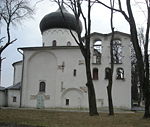Difference between revisions of "Nifont of Novgorod"
m (formatting) |
m (date error) |
||
| Line 18: | Line 18: | ||
before=John| | before=John| | ||
title=Bishop of Novgorod| | title=Bishop of Novgorod| | ||
| − | years= 1130- | + | years= 1130-1156| |
after=?}} | after=?}} | ||
{{end box}} | {{end box}} | ||
Revision as of 21:18, May 21, 2009
Our father among the saints Nifont of Novgorod, also Niphon of Novgorod, was the Archbishop of Novgorod in the first half of the twelfth century during a time of political crisis in Novgorod. He conducted a strong program of evangelism among the pagan tribes of the northwestern territories around Novgorod and Pskov. He encouraged the establishment of monasteries with experienced missionary minded monks. He directed the construction of cathedrals in both Novgorod and Pskov. He is commemorated on April 8.
Life
Nifont was born in Greece and came north to the Monastery of the Kiev Caves where he was monk. After Bishop John of Novgorod retired, Nifont was chosen Bishop of Novgorod. He was consecrated bishop in Kiev by Metropolitan Michael in 1130. As much of the area around Novgorod was largely pagan, Nifont chose to concentrate his missionary efforts, first, around Pskov, and then the area of Ladoga, where he laid the cornerstone of the Church of St. Clement in 1153.
After Bp. Nifont’s arrival in Novgorod, the political situation began to shift to election of a “ruling” prince from the local area over one from Kiev. In 1136, the Kiev backed Prince Vsevolod Mstislavich, son of Mstislav Vladimirovich and grandson of Vladimir Monomakh, was banished from Novgorod and replaced by Prince Svyatoslav Olgovich. Prince Vsevolod found refuge in the town of Pskov, a rival of Novgorod. Soon, Bp. Nifont joined Vsevolod in Pskov after he refused a second marriage for Prince Svyatoslav that was against the Church canons. This exile lasted until about 1142.
As part of his evangelical zeal, Bp. Nifont had initiated before his exile a program of repairing and building churches in Novgorod, notably construction of Dormition Cathedral on the market square, in 1135. With his exile to Pskov, Bp. Nifont launched an active evangelistic program in the Russian territories adjacent to the town. Pskov became a center of church and monastery building. Between 1137 and 1142, two monasteries were started in Pskov, the Mirozhsky and the Nativity of St. John the Baptist of Ivanovsky Monasteries, monasteries in which the new missionaries were trained in spreading Christian ideals with sermons that bore personal examples of asceticism. At Mirozhsky Monastery, he also initiated the building of the Transfiguration Cathedral with twelfth century frescos that have survived to today.
After the repose of Metr. Michael of Kiev in 1145, the Grand Prince Isiaiaslav moved to have the schemamonk Clement consecrated to the Kievan see without the blessing of the Patriarch of Constantinople. At a council of bishops, Abp. Nifont voiced his disapproval of this action, advising the council that it was contrary to the tradition of the Russian Church as the Church had received the Orthodox faith from Constantinople. The consecration of Clement took place regardless of Abp. Nifont’s objection. Abp. Nifont thereafter refused to serve with Metr. Clement nor to commemorate him during services.
Clement in turn refuse to let Nifont return to Novgorod, keeping him under house arrest at the Kiev Caves Monastery. After Prince Isiaiaslav was defeated by Prince George I in 1149, Abp. Nifont was released and allowed to return to a joyous Novgorod. Praising in a letter Abp. Nifont’s defense of the traditions of the Church, the Patriarch of Constantinople sent Metr. Constantine to Kiev to depose Clement and assume the see in Kiev.
Abp. Nifont returned to Kiev to meet the new metropolitan, taking up residence again at the Kiev Caves Monastery. While at the monastery, Abp. Nifont became ill. On April 8, 1156, Abp. Nifont reposed after he had seen in a dream thirteen days before St. Theodosius who had told him of his coming death.
| Nifont of Novgorod | ||
|---|---|---|
| Preceded by: John |
Bishop of Novgorod 1130-1156 |
Succeeded by: ? |
Sources
- St Niphon the Bishop of Novgorod
- V. Sarabianov, Transfiguration Cathedral of the Mirozh Monastery, Severny Polomnik, 2002 ISBN 5-94431-033-2
External link
Categories > Church History
Categories > Church History
Categories > Church History
Categories > Liturgics > Feasts
Categories > Liturgics > Feasts
Categories > Liturgics > Feasts
Categories > People > Clergy > Bishops
Categories > People > Clergy > Bishops > Bishops by century > 12th-century bishops
Categories > People > Clergy > Bishops > Bishops by city > Bishops of Novgorod
Categories > People > Missionaries
Categories > People > Saints
Categories > People > Saints > Russian Saints
Categories > People > Saints > Saints by century > 12th-century saints
